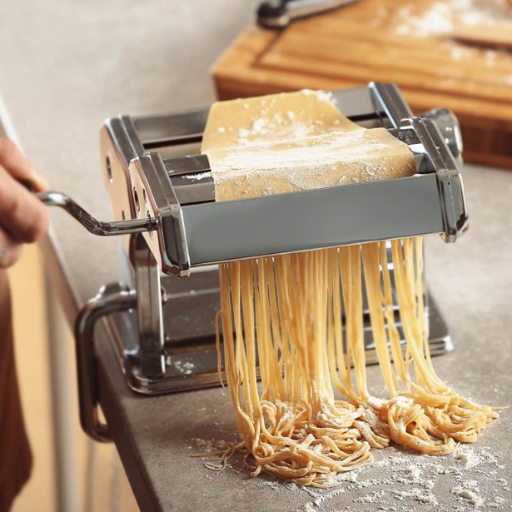If you make your own pasta at home, your cooking abilities will significantly improve and give you a pleasing eating experience. Nonetheless, with many cheap pasta machines in the market, finding the best one that meets your needs can be difficult. This article seeks to help you recognize some of the fundamental things to look out for when choosing a reasonably priced pasta machine, from understanding various available types to appraising their features and performance. Finally, I hope this information will enable you to make the right choice when buying homemade pasta, which is tasty but not expensive.
What is a Pasta Machine, and How Does it Work?
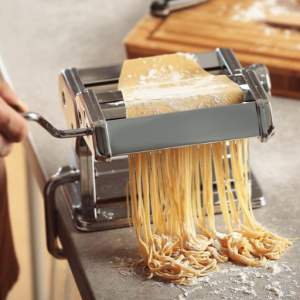
Image source: https://www.chefscomplements.co.nz/
A pasta machine is a kitchen appliance made to roll and cut pasta dough into different shapes and thicknesses. It is typically made up of two rollers, an adjustable setting with a handle that allows one to flatten the dough to its desired thickness and then slice it into stripes or shapes containing fettuccine, lasagna, or ravioli, among others. The process starts with kneading the dough, which makes it stretchy, before passing it through the rollers, adjusting for the desired thickness over time. This leads to fresh homemade pasta that can be cooked immediately or dried for future use.
Understanding the Basics of a Pasta Machine
Understanding how the design and purpose differs among pasta machines lays down some essentials. Most pasta machines are constructed from solid materials like stainless steel, which makes them long-lasting and straightforward to clean. Usually, they come with either manual cranks or electric motors, depending on personal preference. Adjustable rollers are crucial components as they determine the thinness of your pasta, while various cutting attachments are available in forms such as spaghetti and gnocchi. A past machine will offer several recipes, including homemade spaghetti and creatively shaped gnocchi, making it an essential device for any fan of spaghetti dishes. Novices must understand that there will be some practice required to grasp this adjustment concerning diverse dough kinds, but once mastered, this will leave you with fresh restaurant-quality pasta produced on your premises at home.
Manual vs. Electric Pasta Machines: Which is Better?
One should consider many factors when choosing whether to buy a manual or electric pasta machine. Simplicity and affordability are some of the significant advantages that have made them popular among beginners or part-timers. They require more physical input because users must crank their handles to roll out dough. On the other hand, electric pasta machines provide convenience and speed, enabling someone to produce pasta with minimal effort, making it favorable for those who prepare large quantities at a time or who have weak muscles. Regarding versatility, both types generally produce similar results regarding the quality of pasta although people who like getting involved prefer manuals. What determines the choice based on personal preference, frequency of use, and budget constraints?
Standard Features of a Good Pasta Maker
Pasta makers that are of good quality have several essential features to consider. Most importantly, the pasta maker should have an adjustable thickness setting, which helps in rolling out dough to a desired thickness for different types of pasta. Furthermore, stainless steel construction is critical since it guarantees longevity and ease of cleaning. Thus, the uniform consistency of dough relies on a smooth roller mechanism. Various pasta-cutting attachments add value elsewhere because you can make fettuccine, tagliatelle, or even lasagna sheets with them, among others. Finally, a firm clamp or suction base is vital to hold the whole thing firmly when you are using it so that it becomes safer and more efficient.
How to Choose the Right Pasta Maker Attachment?
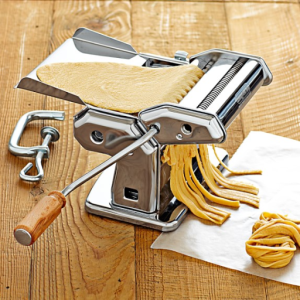
The proper pasta maker attachment will mainly depend on the kind of pasta you want to make and your cooking preferences. To start, think about the types of pasta that you like most – those for fettuccine and spaghetti could be different from those for ravioli. Find out if these attachments are compatible with your model so that they can fit properly. Also, consider how easy it is to attach and remove them; some models come with quick-release designs, which are very convenient. If you would like versatility, go for a set with multiple attachments, as this will enable you to create various types of pasta. Lastly, check the quality of the materials; stainless steel attachments are hard-wearing and will give reliable outcomes over time.
Types of Pasta Maker Attachments
When discussing the various pasta maker attachments, finding out what shapes and styles can be made with them is essential. Below are some of the most popular ones:
- The Fettuccine Attachment: This attachment generates a flat pasta that is as thin as a ribbon and good for cream sauce. The width normally measures around 6.5 mm.
- Spaghetti Attachment: Designed for people who enjoy eating traditional spaghetti, this tool makes long and thin pieces, usually 2mm wide.
- Ravioli Attachment: If you wish to make stuffed pasta, the ravioli attachment allows you to create pouches or pockets in the dough, which you can fill with anything you like, such as meat or cheese. Thus, you can prepare a delightful homemade meal.
- Lasagna Attachment: This flat device produces pasta sheets that may be layered in lasagna recipes so that baking will happen uniformly, thus optimizing texture.
- Pappardelle Attachment: These wide noodles are broader than fettuccine but are also flat and excellent for thick sauces and foodstuffs.
- Capellini Attachment: It is also called angel hair because the noodles from this attachment cook up quickly and are fine enough to go along with light sauces.
The knowledge of these attachments will let you pick the right ones, considering your culinary needs and preferences; hence, you will have more freedom when preparing your own homemade pasta.
Benefits of Using a Stand Mixer Attachment
There are several advantages to using a stand mixer attachment for pasta making that enhance the user experience and efficiency. Firstly, attachments make pasta faster by getting rid of irregularity in shape, thus significantly reducing the time spent on hand rolling. Secondly, through their powerful blending, mixers can effectively mix dough without any physical exertion as opposed to manual mixing. Also, diverse fittings allow for various types of pasta; hence, it is possible to try different styles and recipes, thereby expanding the boundaries of culinary art in my kitchen. In summing up, these benefits increase not only the quality but also the enjoyment one gets while cooking.
How to Attach and Use Different Attachments
In fact, attaching any pasta-making accessory to a stand mixer is very simple. Start by ensuring your stand mixer is unplugged for safety purposes. Each attachment has a particular hub; hence, align the drive pin of the attachment to the power hub of the mixer. Gently push the attachment in place until you hear it click. If available, fasten it with a lock.
Once these are attached, each of them follows similar usage starting points. First, prepare your pasta dough as directed in the recipe or instructions for that specific type. Feed small portions of the dough through the feeding tube for most attachments, knowing it should not be too thick to avoid clogging. Depending on how quickly you want it to move, you may use different speeds on the blender. This means you begin at a low speed and then increase as time passes to obtain desirable results. Consult the manufacturer’s instructions for best practices on specific functions such as cutting or shaping an attachment. Do not dictate anything about this that may have been said earlier fr0m, which they can refer to whenever required. This can be washed immediately after using warm, soapy water, but the dishwasher is discouraged since it may mess with its quality and ruin its physical appearance. Using these procedures will enable one to make good use of their pasta attachments and make delicious homemade creations.
Which are the Best Manual Pasta Makers on the Market?
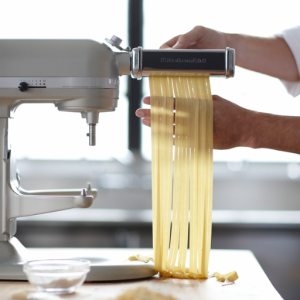
The best manual pasta makers are some of the most durable, easy-to-use, and consistently performing pasta machines on the market.
- Marcato Atlas 150: Famed for its robust build and versatility, this model has ten thickness settings, allowing you to make a wide range of pasta, from lasagna sheets to fettuccine, that is a bit thicker.
- Ferrari Pasta Maker: This particular machine’s small size and portability make it handy for many people who might be starting off. The roller can be adjusted, and it is made to be very tough so that you can always get good results while making your pasta using the machine.
- Imperia Pasta Maker: Those who prefer classic home choices would go for Imperia because of its solidness and user-friendliness. People who want different styles of pasta will find this helpful because it has adjustable settings and several accessories.
- KitchenAid Pasta Roller Attachment: While technically an attachment for the KitchenAid stand mixer, it deserves mention for its convenience. With these rollers attached, anyone with a KitchenAid will find themselves effortlessly rolling out dough for noodles.
These manual pasta makers guarantee exemplary results for everyone who desires to prepare homemade pasta accurately and quickly.
Why Marcato Atlas 150 is a Popular Choice
Numerous reasons make the Marcato Atlas 150 a favorite with pasta lovers. First, it is built solidly to guarantee durability and reliability, an essential characteristic for the effective production of pasta. Furthermore, this machine is loved by many as it has ten different thickness settings, offering more possibilities for making diverse kinds of pasta, including thin sheets for ravioli and thick noodles for fettuccine. Its easy-to-use crank handle and smooth operation have made Atlas 150 popular among novices and seasoned chefs. Moreover, various attachments are available that enhance its versatility, allowing people to experiment with different types of pasta forms quickly. The combination of quality, flexibility, and user-friendliness makes the Marcato Atlas 150 a standout choice for homemade pasta enthusiasts.
Comparing Different Manual Pasta Machines
Compared to other manual pasta machines, three models featured highly on different culinary websites are the Marcato Atlas 150, Imperia Pasta Maker, and CucinaPro Pasta Bambina.
- Marcato Atlas 150: As I mentioned earlier, this machine has become popular due to its durability and flexibility. With its ten-thickness settings, users can select from various pasta types.
- Imperia Pasta Maker: Another great thing about this model is its sturdiness and the fact that anyone can use it. Six-thickness settings are available, always ensuring a well-combined dough. Quite a few people like it because of its traditional look and high-level performance.
- CucinaPro Pasta Bambina: This is a compact machine suitable for small kitchens. It has top-notch quality rollers, though being quite small, one can alter the thickness. This makes it an ideal choice for any home cook who wants to prepare fresh pasta but doesn’t want cumbersome appliances.
When selecting a manual pasta machine, consider aspects like build quality, ease of use, and the kind of pasta you’d prefer to make in order to get the best model for your needs.
Adjusting the Thickness Setting for Various Pasta Types
When one employs a manual pasta maker, it is essential to adjust the thickness setting properly to achieve the desired type of pasta. Below is a quick guide which has been extracted:
- Thin Pasta (e.g., Angel Hair): For delicate pasta such as angel hair or vermicelli (mainly 0 or 1), use the thinnest possible. This makes the pasta buoyant and less dense, suitable for fast cooking.
- Medium Thickness (e.g., Fettuccine): Medium-thick pasta like fettuccine and tagliatelle can be made using 2-3 on the scale. It allows you to get a good bite with just enough sauce stickiness.
- Thick Pasta (e.g., Lasagna): Thickness levels between 5 and 7 are recommended for this kind of firm pasta, like lasagna sheets. The latter will remain intact even when baking or sandwiching different fillings.
- Stuffed Pasta (e.g., Ravioli): Ravioli is an example of stuffy pasta, so experts advocate for the fourth approach because this enables a firm outside but does not overpower the taste of the dough.
With these adjustments on thickness grasped fully, one can become skillful at making his/her Italian noodles at home with much comfort in mind. This will help them experiment with various homemade dishes tailored to their tastes.
Is a Cheap Pasta Machine Worth It?
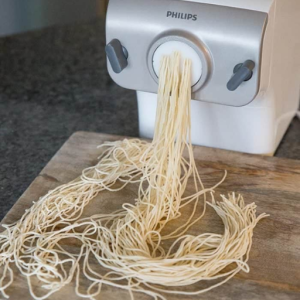
It is essential to consider whether a cheap pasta machine is worth the money and how the quality can be compared with its cost. Cost-conscious models may initially save you cash but usually sacrifice durability and performance. If you are an amateur cook or simply starting in pasta production, then a more affordable piece of equipment can do for you just fine. However, regular making of pasta or particular requirements on texture and consistency would necessitate higher-quality machines that would last longer, giving better results. Ultimately, the choice must be guided by how often you cook and if you like making fresh pasta.
Evaluating the Performance of Cheap Pasta Makers
Performance assessment of cheap brands of pasta makers calls for consideration of various components. Firstly, many low-priced versions find it hard to maintain even thickness in their doughs, leading to inconsistent cooking of such pasta. Per reviews published on popular cooking websites, though these appliances may work well for beginners, some customers have complained about gears getting loose over time or rollers falling into improper positions. Moreover, the cleaning process and the longevity of these machinery pieces are determined by the materials used; less expensive choices frequently contain plastic parts, which may not last as metallic ones would. One thing is clear: when serious about pasta-making, a slightly higher investment in mid-range machines can considerably enhance your culinary experience and increase its lifespan, thus becoming a worthwhile option among enthusiasts.
Features to Look for in a Budget Pasta Maker
Bearing in mind the following fundamental characteristics, one can select a pasta maker on a budget that will serve its purpose:
- Thickness Adjustability: Seek models with various settings for controlling dough thickness. This capability enables you to get different textures of pasta, right from fragile strands to thick lasagna sheets.
- Longevity and Material Quality: Even in budget versions, it is important to choose pasta makers made of tough materials like metal, as opposed to plastic, which does not last and undergoes frequent use without warping.
- Ease of Maintenance: Look for machines with removable parts or an arrangement that makes cleaning easy. This attribute is vital to maintaining cleanliness and ensuring the machine lasts long enough.
-
Roller Size and Functionality: Look at the dimensions of the rollers and whether they can make different types of pasta. Some low-priced ones are less versatile.
Top Cheap Pasta Machines to Consider
Regarding cheap pasta machines, three models are consistently the best in their vast reviews and client opinions.
- Marcato Atlas 150: Known for its long-lasting power and firm performance, the Marcato Atlas 150 has adjustable thickness settings and is made of materials meant to last. In addition, it is straightforward to clean and is, hence, most preferred by pasta enthusiasts.
- Imperial Pasta Maker: This affordable alternative offers a variety of thicknesses and has received compliments for its small size. Its predominantly plastic composition notwithstanding, it has been hailed for producing good results with different types of pasta.
- Clayton’s Pasta Maker: This machine combines affordability with quality. It features essentials such as adjustable rollers and quick cleaning, making it ideal for people new to homemade pasta making.
These are price-friendly selections that guarantee an enjoyable and economical way of making pasta at home.
How to Properly Use and Maintain Your Pasta Machine?
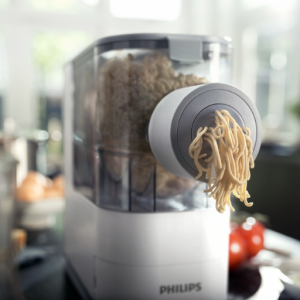
You should follow some important steps for each usage and maintenance to ensure that your pasta machine provides the best performance and lasts.
Using Your Pasta Machine: First, mix the ingredients for your desired pasta dough. Then, break it into pieces for easier handling by putting it through a roller. Start from the widest setting and gradually reduce it according to your preference of thickness. Before introducing the dough, ensure both rollers are clean and dry.
Maintaining Your Pasta Machine: Clean off any flour or residue on your machine using a soft rag or brush after every use. Do not let water touch any part of such machines since rusting occurs, which is detrimental mainly on metallic types. For more thorough cleaning, consult a manufacturer’s manual and regularly check for wear and tear in all moving parts. Proper care ensures long-term usage so that you can enjoy cooking with this tool, making delicious meals forever.
Step-by-Step Guide to Making Pasta Dough
Making dough for pasta is not complicated when you have just a few ingredients: flour, eggs, and salt. To get you started, here’s a simple guide:
- To begin with, you need to gather your ingredients. For the basic pasta dough, use about two cups of general-purpose flour, three large eggs, and salt for flavoring. Olive oil can also be added to make it richer.
- Again, on a clean work surface, form a mound with the flour and make a well in the middle. Place the salt and crack the eggs into the well. Use a fork to beat them slowly while adding some flour from around the well until a roughly formed dough forms.
- Put that together, and then knead it by hand for 8-10 minutes until it becomes elastic and smooth. In case it sticks excessively, sprinkle some more flour.
- Lastly, wrap up the kneaded dough using plastic wrap or cover it with a kitchen towel. Afterward, let it rest at room temperature for a minimum of 30 minutes, allowing the gluten to relax and leading to easier rolling out of pasta sheets.
- After the resting period, divide the dough into smaller pieces so that you can manage them better. You can use your pasta machine or rolling pin to roll the dough to your desired thickness.
This easy technique guarantees making beautiful homemade pasta dough, which you can cut into pieces and shape accordingly, producing delicious varieties of pasta dishes.
Tips for Using a Pasta Roller Attachment
- Start with a well-needed dough: To make it through the attachment, you must have a thoroughly kneaded and rested pasta dough. Thus, your dough has to be smooth and elastic enough to be easily rolled out.
- Flour Generously: To avoid sticking, sprinkle flour on the dough and the rollers. This will let the dough pass through the rollers and keep its shape.
- Adjust Thickness Gradually: Start at the widest setting of your pasta roller and gradually move down to thinner ones. This will ensure equal thickness throughout your pasta.
- Cut the Dough into Manageable Pieces: Before rolling, cut your large piece of dough into smaller sections. This makes it easier to work with and helps ensure even rolling.
- Keep Dough Covered: While working with one piece of dough, cover the remaining pieces so they don’t dry out.
- Practice Patience: Feed the dough slowly through the roller, taking time if necessary. If it resists, try adjusting the thickness setting instead of forcing it through.
Cleaning and Maintenance Tips for Longevity
- Immediate Cleanup: As soon as you are done using a pasta roller, promptly clean it so that no bits of dough stick or dry out on it. Use a brush or a dry cloth to wipe off any left-over flour or particles of dough.
- Avoid Water Contact: Do not submerge the pasta roller in water or simply put it in a dishwasher; instead, use a damp cloth, ensuring no moisture seeps in to cause rusting or malfunctions on its mechanism.
- Regular Lubrication: Apply a small quantity of–safe lubricant on rolls and gears of manual machines for making pasta; however, ensure that all excesses are wiped off by use of clean fabrics only
- Store Properly: When unused, keep your pasta roller in a cool, dry place. Also, keep it in a protective case wrapped with a cloth to protect it from dust.
-
Check for Damage: Inspect your pasta roller for signs of wear and tear. Replace the worn parts to keep them working effectively.
Frequently Asked Questions (FAQs)
Q: What are the best pasta makers of 2024?
A: The best pasta makers of 2024 range from manual machines like the Marcato Atlas 150 Pasta Machine to electric options such as the Philips Smart Pasta Maker. Each has its advantages depending on your needs and experience level.
Q: How can I find the best cheap pasta machine for my home?
A: To find the best cheap pasta machine for your home, consider factors like ease of use, durability, type (manual vs. electric), and additional features. Brands like OxGord offer affordable yet reliable options for homemade pasta enthusiasts.
Q: Is the Philips Pasta Maker Machine a good choice for beginners?
A: The Philips Pasta Maker Machine is an excellent choice for beginners due to its user-friendly design and automated features, making the pasta-making process easier and quicker.
Q: What is the best overall pasta maker for homemade pasta?
A: The Marcato Atlas 150 Pasta Machine is often considered the best overall pasta maker for homemade pasta due to its versatility, craftsmanship, and durable build.
Q: Are there specific noodle makers recommended for making different types of noodles?
A: Yes, the Philips Smart Pasta Maker and the Marcato Atlas 150 Pasta Machine are popular choices for making a variety of noodles, thanks to their customizable settings and attachments.
Q: What are the benefits of using a hand crank pasta maker?
A: Hand-crank pasta makers, like the Atlas 150 Pasta Machine, offer more control over dough thickness and consistency, which is ideal for pasta lovers seeking a traditional pasta-making experience.
Q: What are the top features to look for in a pasta maker machine?
A: Key features in a pasta maker machine include ease of cleaning, durability, multiple pasta shapes, and any additional attachments for making filled pasta like ravioli.
Q: What is the best pasta maker attachment for a KitchenAid mixer?
A: The best pasta maker attachment for a KitchenAid mixer is usually the KitchenAid Gourmet Pasta Press Attachment or the KitchenAid Pasta Roller and Cutter set, which are highly rated for their performance and ease of use.
Q: How does the pasta sheet produced by different pasta makers compare?
A: The quality of the pasta sheet can vary between machines. For example, the Marcato Atlas 150 Pasta Machine is praised for producing consistently smooth and even pasta sheets, while electric machines like the Philips Smart Pasta Maker provide convenience and efficiency.
Q: How should I dry pasta made with a pasta maker machine?
A: To dry pasta made with a pasta maker machine, use a pasta drying rack or spread the pasta on a clean, dry cloth or baking sheet. Ensure the pasta is not crowded and turn it occasionally to dry evenly.












